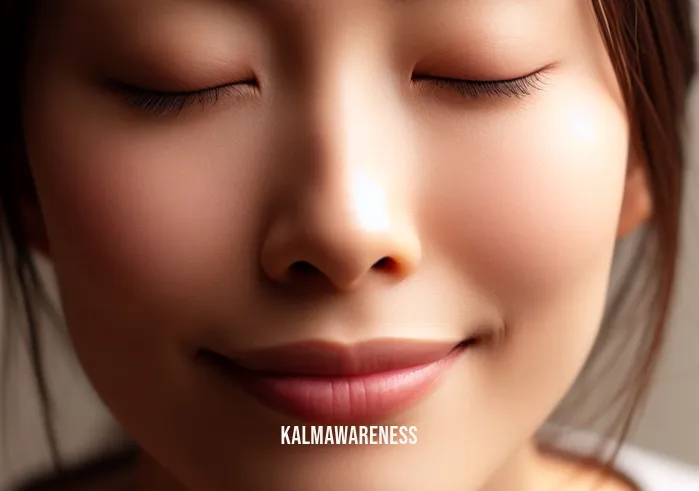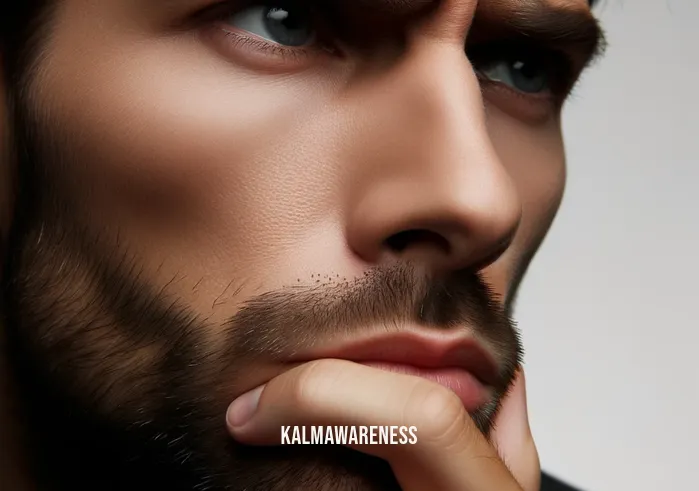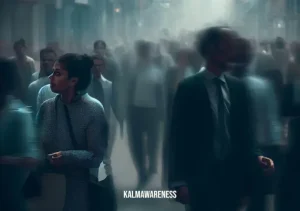Aphantasia and Meditation: A Unique Intersection of Mindfulness
In today’s world, the quest for mindfulness and meditation has expanded, going beyond traditional norms and penetrating various spheres of human experience. One such intersection that has been gaining attention in recent times is between aphantasia and meditation. For those unfamiliar with the term, aphantasia refers to the inability of certain individuals to create mental images or visualize things in their mind. The phenomenon of aphantasia contrasts with our typical understanding of meditation, where visualization often plays a critical role. This segment aims to explore how individuals with aphantasia can still find profound insights and benefits from the practice of meditation.
What is Aphantasia?
Aphantasia is a condition where individuals find it challenging, if not impossible, to conjure up mental images. It’s like reading a vivid book description but not being able to paint the picture in your mind’s canvas. This absence of visual imagination has been intriguing to many, leading to questions about how such individuals experience dreams, memories, and even the process of thinking itself.
It’s fascinating how our brains are wired differently. For some, a reminder to touch that body part might bring forth a clear mental image, while for others with aphantasia, the concept remains abstract. But this doesn’t mean they lack creativity or the ability to conceptualize. Their brains simply process information differently.
Meditation: Beyond Visualization
Meditation, traditionally, has been viewed as a tool that often employs visualization techniques. However, it’s crucial to keep in mind that visualization is just one element of some meditation exercises. The core of meditation revolves around awareness, focus, and achieving a state of mindfulness.
For instance, in practices like mindful movement sleep, participants are encouraged to be present and attuned to their body’s sensations. Similarly, techniques such as mindful hypnobirthing or sessions at Buddhist temples in Kansas City focus on cultivating awareness, which doesn’t necessarily require one to visualize.
The Role of Breathing in Meditation
One aspect that universally permeates various meditation forms, irrespective of the practitioner’s ability to visualize, is the focus on breathing. Breathing is an essential element, whether you’re practicing Rouse Yoga, seeking sustainable self-care, or simply trying to stabilize your thoughts.
For individuals with aphantasia, the emphasis on breathing during meditation can be particularly grounding. It offers a tangible point of focus, enabling them to anchor their awareness in the present moment.
The Path Ahead: Exploring Aphantasia and Mindfulness
The journey of understanding the interplay between aphantasia and meditation is only beginning. As we delve deeper into this topic, we’ll explore how those with aphantasia approach mindfulness, meditation practices tailored for them, and the unique insights they garner from their experiences.
While the conventional means of meditation might involve visualizing serene locales or following guided imageries, a unique path awaits those who perceive the world without the lens of mental imagery. They demonstrate that mindfulness goes beyond the confines of visualization. It’s about being present, being aware, and immersing oneself in the experience, whether it’s during a mindfulness session titled “Be Happy Now” or understanding how we get deep so fast in our meditation practices.
Conclusion
In essence, aphantasia offers a unique perspective on meditation, emphasizing that the practice is accessible and beneficial for everyone, regardless of their ability to visualize. For individuals with aphantasia, meditation can be a transformative journey of self-discovery, grounding, and heightened awareness.
If this introduction has piqued your interest and you’re eager to delve deeper into the nexus between aphantasia and meditation, you’re in for a treat. In the next segment, we will further explore techniques, experiences, and insights that cater to this unique intersection of the mind. Continue reading to embark on this enlightening journey.

Aphantasia and Meditation: Techniques and Approaches
In the quest to uncover the depths of aphantasia and meditation, we venture further into the techniques and tools that cater specifically to those who navigate their mindfulness journey without the aid of visual imagery. As we emphasized earlier, meditation transcends beyond visualization, inviting everyone to experience its profound benefits. Here, we’ll delve into the practical methods and understandings that align with the needs of aphantasia meditators.
Meditation Techniques for Aphantasics
Though the lack of visual imagery might seem like a limitation, many meditation styles are tailored to focus on sensations, sounds, or simply being. Let’s explore a few:
Mindful Movement: Engaging with one’s physical sensations can be immensely grounding. Practicing techniques that emphasize movement, like those found in Jack Kornfield’s Meditation for Beginners, can be particularly enlightening.
Body Scan: A practice where attention is sequentially given to different parts of the body. It cultivates awareness and can be especially useful when practiced lying down, a position that some find beneficial for meditation.
Mantra Meditation: Using a repeated sound, phrase, or word to focus the mind. This auditory technique is beneficial for those who resonate more with sounds than visuals.
Guided Journeys: While these often employ visual cues, they can be adapted to emphasize sounds, feelings, and other sensory experiences. The aim is to immerse oneself into an experience, as seen in practices that revolve around the judgment of the wise.
Benefits of Meditation for Aphantasics
Enhanced Sensory Awareness: Without the distraction of mental imagery, many aphantasics report heightened sensations during meditation, from the rustle of leaves to the feeling of air on the skin.
Deeper Presence: Being present becomes an immersive experience. Meditation techniques, especially those that promote mindfulness, enable them to engage deeply with the now.
Unique Insights: Every individual’s journey with meditation is personal. Aphantasics often uncover insights and understandings that might be overlooked by others.
Overview of Meditation Techniques for Aphantasics
| Technique | Focus | Link to Learn More |
|---|---|---|
| Mindful Movement | Physical Sensation | Meditation Made Simple |
| Body Scan | Bodily Awareness | Can U Meditate Lying Down? |
| Mantra Meditation | Auditory | One for Each Blessed Day |
| Guided Journeys | Multi-sensory | Judgment of the Wise |
The Road Ahead: Meditation Tailored for Aphantasia
Meditation, in its essence, is about creating a deep connection with oneself. For those with aphantasia, it’s a reminder that meditation isn’t merely about what one can see in their mind’s eye but about experiencing every sensation, every emotion, and every thought in its raw, unfiltered form.
As we pave the way for deeper exploration, our next chapter promises to dive into personal experiences and testimonials, shedding light on the transformative journeys of individuals with aphantasia as they tread the path of mindfulness. Whether you’re an aphantasic, a seasoned meditator, or someone newly venturing into the world of meditation, there’s a wealth of insights awaiting in the chapters ahead. Continue reading to immerse yourself further into this captivating realm.

Aphantasia and Meditation: Stories of Hope and Transformation
The journey of aphantasia and meditation is laden with profound realizations, moments of clarity, and transformative experiences. Delving into this unique intersection, we uncover tales of individuals who, despite lacking visual imagery, have found solace, hope, and profound insight through the practice of meditation. Their stories are a testament to the boundless possibilities of the human mind and spirit.
Real-Life Inspirations: Tales of Triumph
Sarah’s Awakening
Sarah, an artist with aphantasia, always felt a disconnect with traditional visualization-based meditation practices. While she couldn’t see images, she found her solace in the rhythms of nature and the tactile sensation of her art. Drawn to teenagers walking as a form of meditative practice, she began her walks amidst nature. Each step, each rustling leaf, became a meditation. Her story underscores that sometimes, it’s not about seeing, but feeling.
“The mind’s eye might be blind, but the heart sees all.” – Sarah
Michael’s Sonic Journey
Being a musician, Michael always connected deeply with sounds. Aphantasia, for him, was a doorway to a different kind of meditation, one that resonated with the element of some meditation exercises that focus on auditory experiences. Using the principles from Jack Kornfield’s Meditation for Beginners, he crafted his meditative sessions around soundscapes.
“In the silence of imagery, I found the symphony of sound.” – Michael
Anaya’s Mindful Moments
Anaya, a therapist, encountered many clients who struggled with aphantasia. Inspired by mindfulness practices, she developed a series of non-visual meditation exercises. Drawing from techniques in mindful hypnobirthing, she emphasized grounding, bodily sensations, and the richness of the present moment.
“When one door closes, another opens. The canvas of the mind might be blank, but it’s teeming with sensations, emotions, and boundless potential.” – Anaya
Why These Stories Matter
These narratives shine a light on the universality of the human experience. Aphantasia, rather than being a hindrance, can be a unique lens to experience the world. As these individuals have shown, the path to mindfulness and meditation is as diverse as humanity itself. The absence of mental imagery doesn’t limit the depth and breadth of meditative experiences; it simply offers a different, equally enriching journey.
Looking Forward: Expanding Horizons
The tales of Sarah, Michael, and Anaya are but a glimpse into the vast expanse of experiences that lie at the intersection of aphantasia and meditation. As we forge ahead, we’ll delve deeper into techniques, scientific insights, and more personal stories that will further illuminate this intriguing realm.
In the next chapter, we’ll explore the science behind aphantasia and its interplay with meditation. From neuroscientific perspectives to the latest research, we’re about to embark on a fascinating voyage into the intricacies of the mind. Continue reading to venture further into this enlightening domain.

Aphantasia and Meditation: The Science Unraveled
While personal stories and experiences shed light on the transformative journey of aphantasia and meditation, understanding the science behind this unique intersection adds depth to our comprehension. In this chapter, we dissect the intricacies of both these phenomena, looking closely at what scientific research and studies have unveiled.
Neurological Insights into Aphantasia
Brain Wiring: Studies have indicated that aphantasia might be linked to the brain’s wiring, particularly the connections between the frontal and parietal lobes. This doesn’t mean one part is deficient but rather functions differently.
Visual Cortex Activation: In typical visualizers, imagining an image lights up the visual cortex similarly to actually seeing it. For aphantasics, this activation is less pronounced.
Emotional Responses: Research suggests that aphantasics might process emotions differently, not necessarily in intensity but in the manner of processing. For instance, recalling an emotional event without visual imagery can lead to different emotional experiences.
Meditation: Beyond Just Visualization
Awareness and Focus: Meditation is primarily about cultivating awareness, sharpening focus, and achieving a heightened state of consciousness. Visualization is merely one of the many tools in the meditative arsenal.
Sound and Sensation: Many meditation techniques, as explored in Meditation Made Simple, emphasize auditory or tactile experiences over visual cues.
Breath-Centered Practices: Breathing, a cornerstone of meditation, serves as a powerful focal point, making techniques like mindful movement sleep accessible to everyone, irrespective of their ability to visualize.
Benefits of Meditation for Aphantasics: A Recap
Deepened Sensory Experience: Being in the present moment can lead to enhanced sensory experiences, as the mind isn’t clouded by visual distractions.
Emotional Grounding: As indicated by practices in mindful hypnobirthing, grounding exercises can help aphantasics connect deeply with their emotions, facilitating emotional processing and healing.
Cognitive Advantages: Meditation, in general, offers a plethora of cognitive benefits, from improved focus to enhanced creativity. For aphantasics, these benefits can be more pronounced in certain non-visual domains.
A Look Ahead: Synthesizing Knowledge with Practice
As we’ve broken down the science behind aphantasia and meditation, we’ve gained insights into the functioning of the brain and the myriad ways one can engage in meditation. It’s a testament to the adaptability and vastness of human experiences.
Our journey, however, isn’t over. In the final chapter, we will integrate all that we’ve learned, weaving together personal stories, techniques, and scientific insights. As we conclude our exploration, we will provide a comprehensive guide for those with aphantasia looking to embark on their own meditative journeys. Continue reading to witness the culmination of this enlightening voyage.

Aphantasia and Meditation: Charting New Pathways
As we draw our exploration to a close, it’s evident that the realm of aphantasia and meditation is as vast and varied as the human mind itself. We’ve embarked on a journey from understanding the intricacies of aphantasia, delved into personal tales of hope, and unraveled the scientific nuances behind it all. This final chapter seeks to encapsulate our insights, offering a beacon for those navigating the crossroads of aphantasia and meditation.
A Journey Revisited: Key Takeaways
Aphantasia’s Essence: It’s not a lack but a different way of experiencing the world. Absence of visual imagery opens doors to heightened sensations, emotions, and auditory experiences.
Meditation’s Versatility: From mindful movement sleep to soundscapes and body scans, meditation’s essence is adaptability. It offers tools for everyone, irrespective of their visual capabilities.
Empowerment through Stories: Personal narratives, be it Sarah’s nature walks or Michael’s sonic journey, highlight the transformative power of tailored meditation techniques.
Science Meets Experience: The neuroscientific insights into aphantasia, coupled with the vast array of meditative techniques, underscore that meditation transcends beyond mere visualization.
Applying Your Insights
As you move forward, remember:
Explore and Adapt: Whether you have aphantasia or not, the world of meditation is vast. Explore techniques, adapt them to your needs, and remember, there’s no one-size-fits-all.
Revisit and Reflect: If certain concepts intrigued you, consider revisiting previous sections or exploring more on how we get deep so fast in our meditation practices.
Engage with the Community: Connect with others, share experiences, and learn from diverse journeys. You’re not alone in your quest for mindfulness.
A Call to Action: Embark on Your Own Journey
While we’ve charted the landscape of aphantasia and meditation, this is just the beginning. Our magazine is teeming with insights, stories, and guides on mindfulness, meditation, and much more. Delve deeper, explore other topics, and let your journey of self-discovery continue. Whether it’s understanding the nuances of mindful hypnobirthing or the practices at Buddhist temples in Kansas City, there’s a trove of knowledge waiting for you.
Gratitude and Looking Ahead
Thank you, dear reader, for accompanying us on this enlightening voyage. Your curiosity and thirst for knowledge have made this exploration meaningful. As we conclude this edition, rest assured, more insightful content awaits in our future publications. Here’s to the never-ending journey of understanding the mind and its myriad wonders!
Until next time, stay curious, stay mindful, and remember: Every journey, no matter how unique, has its own beauty and wisdom to offer.





